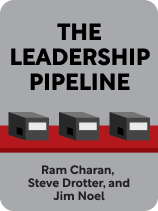

This article is an excerpt from the Shortform book guide to "The Leadership Pipeline" by Ram Charan, Steve Drotter, and Jim Noel. Shortform has the world's best summaries and analyses of books you should be reading.
Like this article? Sign up for a free trial here.
What are the stages of leadership development? How does each step in the Leadership Pipeline lead to the CEO?
There are six stages to describe the hierarchy of management in the largest organizations. If you work in a smaller organization, you may need to leave out or adapt some stages of the Leadership Pipeline.
Let’s look at the specific requirements for each stage of leadership development.
Stage #1: Line Manager
The first stage of leadership development is the line manager (or, as the authors of The Leadership Pipeline call it, the “first-time manager”). Line managers are those who directly manage a team of front-line workers: employees, such as salespeople and programmers, who directly handle the organization’s day-to-day operations rather than managing others. Often, line managers are former front-line workers who showed enough leadership potential to get promoted.
According to the authors, many new line managers struggle to make a necessary mindset shift: to value the results they achieve through others rather than only identifying with their own work. This shift is challenging because line managers used to be front-line workers, to whom it often seems like managers don’t do real work at all. New managers need to realize that skilled management is just as important and productive as front-line work, even if it’s a level removed from the work they’re used to accomplishing.
Stage #2: Second-Level Manager
The second stage of the Leadership Pipeline is the second-level manager (what the authors call the “manager of managers”). Second-level managers are in charge of several teams and responsible for the performance of line managers.
Second-Level Managers Must Coach Line Managers
Second-level managers must train line managers in the basics of management. This can be challenging—evaluating management work is more difficult than judging front-line work, as it’s more abstract. For instance, it’s harder to judge a manager’s ability to delegate than it is to judge the number of deals a salesperson made this month.
When evaluating line managers, second-level managers must be strict but not too strict. They should allow their line managers to make the mistakes they need to learn but shouldn’t hesitate to replace them if they make too many mistakes. The authors argue that leaving ineffective team members in the wrong jobs is one of the most common and harmful errors that organizations make. If just one line manager fails to manage well, they prevent all their subordinates from getting the experience they need if they want to one day become managers themselves. Consequently, the Leadership Pipeline grinds to a halt.
Stage #3: Functional Manager
The third stage of the Leadership Pipeline is the functional manager. The authors explain that functional managers are in charge of a functional department, which is part of an organization that comprises all the teams working to accomplish a single specialized function. For example, a functional manager could be in charge of a research and development department made up of all the teams devising new products, or a marketing department made up of all the teams working to make products appealing to customers.
According to the authors, functional managers need to understand their organization’s big-picture strategy at a much deeper level than second-level managers, since they’re the ones who decide on a strategy for the entire department. Whereas line and second-level managers must come up with ways to accomplish certain tasks, functional managers must decide what those tasks are. This functional strategy should contribute to the organization’s big-picture goals as much as possible.
Functional Managers Must Manage Work They Don’t Understand
The primary skill functional managers must learn is how to make decisions regarding situations that they know very little about, assert the authors. Functional managers can’t be experts in all the different types of work they’re managing. They’re in charge of too many teams, most of which involve work they’ve never done firsthand. This is a difficult challenge to overcome for many newly promoted functional managers, as they’re often hesitant to admit what they don’t know, fearing that it would damage their credibility.
The key to making decisions in unfamiliar situations is gathering ample firsthand information. The authors explain that functional managers can only make wise strategic decisions if they actively listen to team members who are closer to front-line work. To do this, they should have frequent one-on-one conversations with lower-level managers and workers across a wide range of teams.
Stage #4: Company Manager
The fourth stage of the Leadership Pipeline is the company manager (what the authors call the “business manager”). These managers are in charge of entire companies—although they still report to higher-ups in their organization’s parent company.
For the first time, company managers are fully responsible for their business’s overall financial performance, and it’s up to them to figure out how to achieve long-term profitability. The authors assert that to do this, company managers must internalize an understanding of how the company functions. If they don’t grasp how all the puzzle pieces fit together, they won’t know how to bring about meaningful profit increases.
Company Managers Must Overcome Personal Bias
The authors assert that one major obstacle preventing company managers from improving their business is personal bias: After they’ve advanced through each stage of the Leadership Pipeline, new company managers are likely to emerge with a bias toward the department in which they served (as well as, potentially, a bias against departments which seemed unimportant or unnecessary to them in their previous position). As a result, they may fail to incorporate all functions into their overall business plan in a way that harnesses each department’s full potential.
Company Managers Must Get Comfortable With Attention
Finally, the authors state that new company managers must learn to cope with increased attention. They’re watched much more closely than lower-level managers—by higher management as well as outside investors who judge the company manager’s every decision. This attention may influence them to make safe decisions rather than optimal ones, which often involve greater risk: A company manager who makes a risky decision and fails will face harsher judgment than if they had played it safe and failed. However, company managers learn how to improve the company by taking risks and making mistakes—if the fear of being poorly judged discourages them from doing this, it can greatly hinder the business’s success.
Stage #5: Multi-Company Manager
The fifth stage of the Leadership Pipeline is the multi-company manager (what the authors call the “group manager”). Multi-company managers are high-ranking corporate executives who oversee multiple company managers and report directly to a conglomerate’s CEO.
Multi-Company Managers Must Become Hands-Off Mentors
To succeed, multi-company managers must learn to be completely hands-off mentors to the company managers below them. The authors explain that this is often a major struggle. Because they’ve progressed this far in the Leadership Pipeline, multi-company managers are all very proficient business leaders—but the multi-company manager role doesn’t involve using these skills. Coaching and supervising company managers as they make all the strategic decisions typically feels much less exciting.
The authors warn that multi-company managers should never force their strategies on their subordinate company managers. Taking over a company manager’s job by telling them exactly what strategies to execute deprives them of the leadership experience they need to become a dependable higher-ranking executive in the future. This can be disastrous, as weak executives in influential positions can do tremendous damage to an organization.
Multi-Company Managers Must Manage a Portfolio of Businesses
While coaching company managers, multi-company managers also have to know how to realistically predict how successful each company will be, explain the authors. This is because they’re also in charge of managing the corporation’s portfolio of businesses: They move resources from across the conglomerate to the companies that can most successfully utilize them to accomplish the organization’s ultimate mission (as defined by the conglomerate CEO).
Stage #6: Conglomerate CEO
The sixth and final stage of the Leadership Pipeline is the conglomerate CEO (or, as the authors call it, the “enterprise manager”). Such CEOs are in charge of the bottom-line success of a global conglomerate and all its subsidiary companies.
Conglomerate CEOs Must Balance Short- and Long-Term Results
According to the authors, good conglomerate CEOs ensure that their organization achieves both short-term and long-term results. To succeed in the short term, CEOs must make sure that all company processes are working as optimally as possible. Such oversight requires them to understand in detail how every one of their subsidiary businesses functions and stay constantly aware of any changes. This is especially challenging since many team members tend to hide bad news from the CEO, preventing them from solving the problems that impede short-term results.
To succeed in the long term, CEOs must envision the ideal position for their organization in the global market and make sure that all of their decisions steer the organization toward that ultimate goal. Such large-scale changes occur at a glacial pace, and CEOs often struggle to work on such long timeframes. However, if they become impatient and pivot away from a long-term strategy before it has time to pay off, they’ll never achieve success on this scale.

———End of Preview———
Like what you just read? Read the rest of the world's best book summary and analysis of Ram Charan, Steve Drotter, and Jim Noel's "The Leadership Pipeline" at Shortform.
Here's what you'll find in our full The Leadership Pipeline summary:
- Why most organizations end up full of unqualified managers
- The six different levels of management necessary to run any large organization
- The biggest mistake CEOs make that holds them back from success






